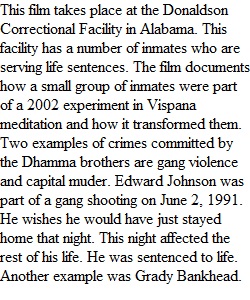


Q For this writing assignment, you are asked to answer the following three questions based on your understanding of the documentary, The Dhamma Brothers, which was assigned in a previous week’s reading/viewing assignments. The three questions differ substantially in character, moving from relatively brief and factually-based to more in-depth and interpretive. While you will probably be able to answer the first question in one sentence, the second will probably take a good paragraph and the third several paragraphs. Likewise, while you will find the answers to the first (and perhaps second) question readily apparent in the documentary itself, the third (and to some extent the second) will require some critical thought and contribution on your part. The questions are as follows: 1. What types of crimes have the Dhamma Brothers committed? Cite two examples. 2. Shortly after beginning the Vipassana, a storm hits the prison. Explain how the imagery of a storm applies to the struggles of the prisoners, tying your answer to the understanding of Vipassana provided in the film. 3. “Blessed are we who live amongst those who hate, without hating.” This quote from a Dhamma brother, at the end of the film, suggests that some of the prisoners had experienced a deep and significant transformation. How can sitting in silence affect such a deep change within such a violent and hate filled context? Most importantly, how does their experience affect their lives when they return to the larger prison population? Basic Requirements: 1. Your paper should be a minimum of three pages in length, double-spaced. 2. You must cite the documentary directly at least two times in your paper. (We will discuss how to do this in class). 3. You should be as detailed oriented in your answer as possible. If you wander off into vague generalities, you’re doing it wrong (this is especially true for the third question). You should be drawing on specific details to develop an informed, empathic understanding of the experiences represented in the film. Grading Rubric Grading for the questions will be as follows: Question #1 (20 points): this is a fact-based question, which means that it is either right or wrong, meaning that an answer will receive all 20 points or none of them. Allowances may be made at the instructor’s discretion for answers that are incorrect but which still indicate an adequate familiarity with the material, but only when such answers arise out of misunderstanding rather than ignorance. Question #2 (30 points): this question is based in fact, but also requires the answer to draw on his or her familiarity with the Buddhist tradition as cultivated in the first half of the semester. 15 points are awarded for the students ability to identify the relevant material in the film (this is factually based, and graded like question #1), and the other 15 points are awarded to the extent that the student is able to relate that material to the relevant aspects of the Buddhist tradition in an informed way. Question #3 (40 points): this question draws on the student’s critical thinking skills, and are thus awarded less for the ability to arrive at the “right answer” than the ability to constructively apply what one does know about Buddhism to address what one may not know about it. Points for this question will be awarded relative to the extent that a student demonstrates a basic understanding of Buddhism (15 points), an informed familiarity with the documentary (15 points), and an ability to constructively bring the two together into a coherent whole (10 points). Meeting basic parameters (10 points): pertains to page length requirement, use of two citations from the documentary, and reliance on details to drive interpretation. Rubric Some Rubric Some Rubric Criteria Ratings Pts This criterion is linked to a Learning OutcomeQuestion 1 Description of the crimes. 20 to >0.0 pts Full Marks 0 pts No Marks 20 pts This criterion is linked to a Learning OutcomeQuestion 2 Explanation of storm imagery. 30 to >0.0 pts Full Marks 0 pts No Marks 30 pts This criterion is linked to a Learning OutcomeQuestion 3 Informed empathic understanding of transformational experiences. 40 to >0.0 pts Full Marks 0 pts No Marks 40 pts This criterion is linked to a Learning OutcomeBasic requirements Length, citations, reliance on detail. 10 pts Full Marks 0 pts No Marks 10 pts Total Points: 100 PreviousNext
View Related Questions